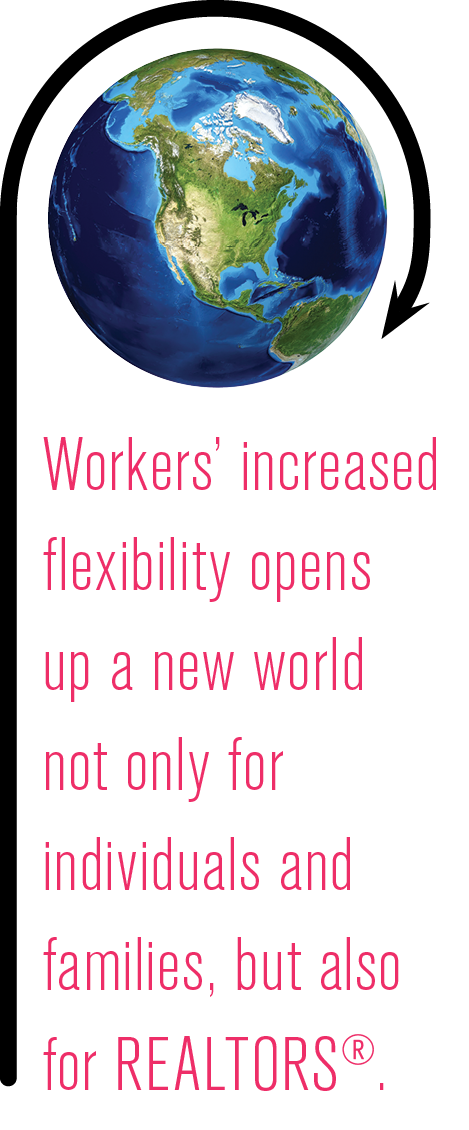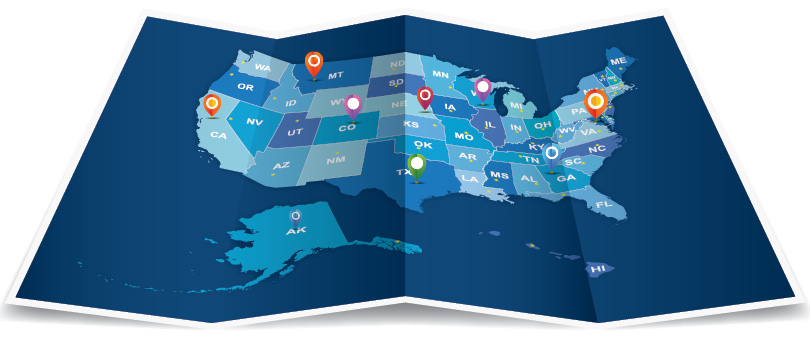An extraordinary number of people have relocated since the start of the pandemic
By Matt Alderton
COVID-19 has changed the way Americans think about health and hygiene. It’s changed how they socialize and where they travel. It’s changed their shopping, dining and even grooming habits. Mostly, though, it’s changed how they work. And as a result, where they live.
 In fact, the National Association of REALTORS® reported in December 2020 that 8.9 million people had relocated since the start of the pandemic.
In fact, the National Association of REALTORS® reported in December 2020 that 8.9 million people had relocated since the start of the pandemic.
Some people have moved for financial reasons, like unemployment. Others because they wanted to reduce their risk of contracting the virus. Many, however, have moved for the simple reason that they can. Thanks to remote working, fewer companies are requiring employees to be in the office. That means workers who no longer have to commute can live on the other side of town. Or if they choose, the other side of the country.
“COVID-19 has taught us all the importance of reconnecting with family and friends, and of being in a community. That is causing a huge shift in our population,” says Shelley Watkins, CRS, an associate broker at LAH Real Estate in Birmingham, Alabama.
Workers’ increased flexibility opens up a new world not only for individuals and families, but also for REALTORS®, who can exploit the work-from-home revolution by using the following strategies to build a nationwide referral network that turns relocations into revenue.
Find your feeder markets.
Building a relocation-focused referral network requires knowing who’s moving to your market, and from where.
 Start with the U.S. Census Bureau, which publishes state-to-state, county-to-county and metro-to-metro migration datasets. A Google search for “Census Bureau migration data” will lead you to them.
Start with the U.S. Census Bureau, which publishes state-to-state, county-to-county and metro-to-metro migration datasets. A Google search for “Census Bureau migration data” will lead you to them.
You also can purchase data from the U.S. Postal Service’s National Change of Address (NCOA) database. Although a license can be prohibitively expensive for individuals, a third-party NCOA processing service can help you obtain and parse data at a more affordable price point. In fact, NAR used NCOA data to inform its aforementioned analysis, from which it created free tools that show the top feeder markets for every state and county in the country during the first eight months of the pandemic.
Websites like Redfin and Trulia also publish migration data based on users’ searches.
A DIY approach can give you a good albeit less precise feel for potential feeder markets. Using Google Analytics, for example, you can see where people are located who visit your website; if a lot of people are browsing your listing from a certain state, that’s a good indicator that people there are relocating to your market in solid numbers. You can use Google Ads’ Keyword Planner tool with similar success, suggests Pierre Calzadilla, vice president of growth at Local Logic, which provides geospatial data to customers in the real estate industry. Using the free tool, for instance, you can enter “moving to Chicago from” and see the top Google searches, which suggest strong interest in the Windy City from New York, Boston and California.
Still hungry for intel? You could always solicit anecdotal assessments from moving companies, corporate recruiters and other in-the-know professionals.
Maintain relationships with happy transplants.
Because transplants are like ants—where there’s one, more almost certainly will follow—staying in touch with former transplants you’ve helped can be lucrative as they lure friends, family and colleagues to join them in your market. For example, Watkins says one of her first real estate clients in Birmingham was an executive from Chicago who was looking for a high-end rental. Although luxury rentals in her market were scarce, she found one for him and subsequently received 51 referrals over the course of three years as his company imported out-of-state recruits.
Befriend out-of-market real estate agents.
When it’s safe to congregate in person, REALTOR® Katherine Waters-Clark regularly connects with fellow agents at live industry events.
“I’m meeting agents from all over the country and getting to know who vibes the way I vibe,” says Waters-Clark, an agent at Compass Boston in Winchester, Massachusetts. “When someone impresses me, they become part of my referral network. So when I have a client who’s selling their house to move to San Francisco, I can say, ‘I know three amazing agents in San Francisco who I was just with in April. Let me connect you.’ And those agents will do the same. In fact, I sold a $3 million house this summer to buyers who moved to Boston from Berkeley, California, who were handed to me by another Compass agent.”
Out-of-state agents also are a lucrative referral source for Delinda Crampton, CRS, based in Las Vegas. As team leader of The Crampton Team at Berkshire Hathaway HomeServices Nevada Properties, she gets approximately 20% of her business from agents she meets at industry gatherings. To build and maintain relationships with those agents, she conceived the novel idea of a “referral road trip”: In 2019, she flew to California—one of the largest feeder markets for Las Vegas—rented a car, then spent a week driving from Northern California to Southern California, treating local agents to meals, coffee and cocktails.
“I saw about 125 REALTORS® during that week,” says Crampton, who had to cancel a follow-up trip to Los Angeles and Orange County because of COVID-19; instead, she sent a gift and listing brochures to the agents she’d hoped to meet. “It’s all about deepening relationships.”
Ingratiate yourself with educators and employers.
Every market has institutions and employers that are magnets for relocation. In Birmingham, for example, there is the University of Alabama at Birmingham (UAB), which is constantly attracting new students and employees from across the country and around the world. Watkins offers her services to hiring managers there free of charge.
“I say, ‘Listen: I know you’re hiring a lot of people who are not from the South. Let me help you tell them about Birmingham,’” explains Watkins, who often takes prospective employees on free tours of the city on behalf of UAB. “That’s been a very effective tool because I’m building a reputation for Birmingham, for UAB and for myself just by being an ambassador for my town.”
Read the business section.
Just as companies recruit out-of-state employees, cities and counties recruit out-of-state corporations. The resulting corporate relocations often transplant dozens, hundreds or even thousands of workers.
To get wind of corporate relocations and expansions, keep your eye on your local business journal and the business sections of local, regional and national newspapers. Waters-Clark, for instance, receives news alerts from The Boston Globe. When Amazon recently announced plans to expand its offices in Boston, creating 3,000 new jobs, she heard about it right away.
An even better source of business intelligence can be commercial real estate agents. “My local commercial agents can be a good source of incoming business because they know what’s about to happen before it hits the business journal,” says Watkins, who recalls one lucrative lead in particular. “We found out that State Farm was going to relocate a large group from Atlanta, so we contacted agents there and made a trip to Atlanta to meet with them. We offered to host an informational lunch about Birmingham for the people who were about to move, and that turned out to be a great source of referrals.”
Grow your community and referral network by visiting find.crs.com.
Photo: iStock.com/hudiemm








